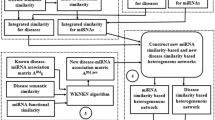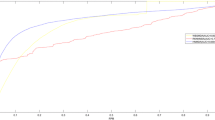Abstract
MicroRNAs (miRNAs) exert an enormous influence on cell differentiation, biological development and the onset of diseases. Because predicting potential miRNA-disease associations (MDAs) by biological experiments usually requires considerable time and money, a growing number of researchers are working on developing computational methods to predict MDAs. High accuracy is critical for prediction. To date, many algorithms have been proposed to infer novel MDAs. However, they may still have some drawbacks. In this paper, a logistic weighted profile-based bi-random walk method (LWBRW) is designed to infer potential MDAs based on known MDAs. In this method, three networks (i.e., a miRNA functional similarity network, a disease semantic similarity network and a known MDA network) are constructed first. In the process of building the miRNA network and the disease network, Gaussian interaction profile (GIP) kernel is computed to increase the kernel similarities, and the logistic function is used to extract valuable information and protect known MDAs. Next, the known MDA matrix is preprocessed by the weighted K-nearest known neighbours (WKNKN) method to reduce the number of false negatives. Then, the LWBRW method is applied to infer novel MDAs by bi-randomly walking on the miRNA network and the disease network. Finally, the predictive ability of the LWBRW method is confirmed by the average AUC of 0.939 3 (0.006 1) in 5-fold cross-validation (CV) and the AUC value of 0.976 3 in leave-one-out cross-validation (LOOCV). In addition, case studies also show the outstanding ability of the LWBRW method to explore potential MDAs.
Similar content being viewed by others
References
Akhtar M M, Micolucci L, Islam S M et al. Bioinformatic tools for microRNA dissection. Nucleic Acids Research, 2016, 44(1): 24-44. https://doi.org/10.1093/nar/gkv1221.
Miska E A. How microRNAs control cell division, differentiation and death. Current Opinion in Genetics & Development, 2005, 15(5): 563-568. https://doi.org/10.1016/j.gde.2005.08.005.
Cheng A M, Byrom M W, Shelton J et al. Antisense inhibition of human miRNAs and indications for an involvement of miRNA in cell growth and apoptosis. Nucleic Acids Research, 2005, 33(4): 1290-1297. https://doi.org/10.1093/nar/gki200.
Xu P, Guo M, Hay B A. MicroRNAs and the regulation of cell death. TRENDS in Genetics, 2004, 20(12): 617-624. https://doi.org/10.1016/j.tig.2004.09.010.
Alshalalfa M, Alhajj R. Using context-specific effect of miRNAs to identify functional associations between miRNAs and gene signatures. BMC Bioinformatics, 2013, 14(Suppl 12): Article No. S1. https://doi.org/10.1186/1471-2105-14-S12-S1.
Fesler A, Zhai H, Ju J. miR-129 as a novel therapeutic target and biomarker in gastrointestinal cancer. OncoTargets and Therapy, 2004, 7: 1481-1485. https://doi.org/10.2147/OTT.S65548.
Wu C, Li M, Hu C et al. Clinical significance of serum miR-223, miR-25 and miR-375 in patients with esophageal squamous cell carcinoma. Molecular Biology Reports, 2014, 41(3): 1257-1266. https://doi.org/10.1007/s11033-013-2970-z.
Xiong S W, Lin T X, Xu K W et al. MicroRNA-335 acts as a candidate tumor suppressor in prostate cancer. Pathology Oncol. Res., 2013, 19(3): 529-537. https://doi.org/10.1007/s12253-013-9613-5.
Zhao H, Zhang J, Shao H et al. miRNA-340 inhibits osteoclast differentiation via repression of MITF. Bioscience Reports, 2017, 37(4): Article No. BSR20170302. https://doi.org/10.1042/BSR20170302.
He F, Lv P, Zhao X et al. Predictive value of circulating miR-328 and miR-134 for acute myocardial infarction. Molecular and Cellular Biochemistry, 2014, 394(1/2): 137-144. https://doi.org/10.1007/s11010-014-2089-0.
Chen X, Xie D, Zhao Q et al. MicroRNAs and complex diseases: From experimental results to computational models. Briefings in Bioinformatics, 2019, 20(2): 515-539. https://doi.org/10.1093/bib/bbx130.
Chen X, Sun L G, Zhao Y. NCMCMDA: MiRNA-disease association prediction through neighborhood constraint matrix completion. Briefings in Bioinformatics, 2021, 22(1): 485-496. https://doi.org/10.1093/bib/bbz159.
Chen X, Zhu C C, Yin J. Ensemble of decision tree reveals potential miRNA-disease associations. PLoS Computational Biology, 2019, 15(7): Article No. e1007209. https://doi.org/10.1371/journal.pcbi.1007209.
Chen X, Huang L, Xie D, Zhao Q. EGBMMDA: Extreme gradient boosting machine for MiRNA-disease association prediction. Cell Death & Disease, 2018, 9(1): Article No. 3. https://doi.org/10.1038/s41419-017-0003-x.
Huang F, Yue X, Xiong Z K et al. Tensor decomposition with relational constraints for predicting multiple types of microRNA-disease associations. Briefings in Bioinformatics. https://doi.org/10.1093/bib/bbaa140.
Zhang W, Li Z S, Guo W Z et al. A fast linear neighborhood similarity-based network link inference method to predict microRNA-disease associations. IEEE/ACM Transactions on Computational Biology and Bioinformatics. https://doi.org/10.1109/TCBB.2019.2931546.
Chen M, Liao B, Li Z. Global similarity method based on a two-tier random walk for the prediction of microRNA-disease association. Scientific Reports, 2018, 8(1): Article No. 6481. https://doi.org/10.1038/s41598-018-24532-7.
Gao Y L, Cui Z, Liu J X et al. NPCMF: Nearest profile-based collaborative matrix factorization method for predicting miRNA-disease associations. BMC Bioinformatics, 2019, 20(1): Article No. 353. https://doi.org/10.1186/s12859-019-2956-5.
Yin M M, Cui Z, Gao Y L et al. LWPCMF: Logistic weighted profile-based collaborative matrix factorization for predicting MiRNA-disease associations. IEEE/ACM Transactions on Computational Biology and Bioinformatics. https://doi.org/10.1109/TCBB.2019.2937774.
Jiang Q, Hao Y, Wang G et al. Prioritization of disease microRNAs through a human phenome-microRNAome network. BMC Systems Biology, 2010, 4(Suppl 1): Article No. S2. https://doi.org/10.1186/1752-0509-4-S1-S2.
Xuan P, Han K, Guo M et al. Prediction of microRNAs associated with human diseases based on weighted k most similar neighbors. PLoS ONE, 2013, 8(8): Article No. e70204. https://doi.org/10.1371/journal.pone.0070204.
Xuan P, Han K, Guo Y et al. Prediction of potential disease-associated microRNAs based on random walk. Bioinformatics, 2015, 31(11): 1805-1815. https://doi.org/10.1093/bioinformatics/btv039.
Chen X, Liu M X, Yan G Y. RWRMDA: Predicting novel human microRNA-disease associations. Molecular BioSystems, 2012, 8(10): 2792-2798. https://doi.org/10.1039/c2mb25180a.
Mørk S, Pletscher-Frankild S, Palleja A et al. Protein-driven inference of miRNA-disease associations. Bioinformatics, 2014, 30(3): 392-397. https://doi.org/10.1093/bioinformatics/btt677.
Shi H B, Xu J, Zhang G D et al. Walking the interactome to identify human miRNA-disease associations through the functional link between miRNA targets and disease genes. BMC Systems Biology, 2013, 7(1): Article No. 101. https://doi.org/10.1186/1752-0509-7-101.
Chen X, Niu Y W, Wang G H, Yan G Y. MKR-MDA: Multiple kernel learning-based Kronecker regularized least squares for MiRNA-disease association prediction. Journal of Translational Medicine, 2017, 15(1): Article No. 251. https://doi.org/10.1186/s12967-017-1340-3.
Chen X, Yan C C, Zhang X et al. WBSMDA: Within and between score for MiRNA-disease association prediction. Scientific Reports, 2016, 6(1): Article No. 21106. https://doi.org/10.1038/srep21106.
You Z, Huang Z A, Zhu Z X et al. PBMDA: A novel and effective path-based computational model for miRNA-disease association prediction. PLoS Computational Biology, 2017, 13(3): Article No. e1005455. https://doi.org/10.1371/journal.pcbi.1005455.
Claude P, Gardès J. Prediction of miRNA-disease associations with a vector space mode. Scientific Reports, 2016, 6(1): Article No. 27036. https://doi.org/10.1038/srep27036.
Chen X, Huang L. LRSSLMDA: Laplacian regularized sparse subspace learning for MiRNA-disease association prediction. PLoS Computational Biology, 2017, 13(12): Article No. e1005912. https://doi.org/10.1371/journal.pcbi.1005912.
Luo J, Xiao Q. A novel approach for predicting microRNA-disease associations by unbalanced bi-random walk on heterogeneous network. Journal of Biomedical Informatics, 2017, 66: 194-203. https://doi.org/10.1016/j.jbi.2017.01.008.
Chen X, Xie D, Wang L et al. BNPMDA: Bipartite network projection for MiRNA-disease association prediction. Bioinformatics, 2018, 34(18): 3178-3186. https://doi.org/10.1093/bioinformatics/bty333.
Chen X, Wang L, Qu J, Guan N N, Li J Q. Predicting miRNA-disease association based on inductive matrix completion. Bioinformatics, 2018, 34(24): 4256-4265. https://doi.org/10.1093/bioinformatics/bty503.
Chen X, Yin J, Qu J, Huang L. MDHGI: Matrix decomposition and heterogeneous graph inference for miRNA-disease association prediction. PLoS Computational Biology, 2018, 14(8): Article No. e1006418. https://doi.org/10.1371/journal.pcbi.1006418.
Zhao Y, Chen X, Yin J. Adaptive boosting-based computational model for predicting potential miRNA-disease associations. Bioinformatics, 2019, 35(22): 4730-4738. https://doi.org/10.1093/bioinformatics/btz297.
Wang L, You Z H, Chen X et al. LMTRDA: Using logistic model tree to predict MiRNA-disease associations by fusing multi-source information of sequences and similarities. PLoS Computational Biology, 2019, 15(3): Article No. e1006865. https://doi.org/10.1371/journal.pcbi.1006865.
Ezzat A, Zhao P, Wu M et al. Drug-target interaction prediction with graph regularized matrix factorization. IEEE/ACM Transactions on Computational Biology & Bioinformatics, 2017, 14(3): 646-656. https://doi.org/10.1109/TCBB.2016.2530062.
Yan C, Duan G H, Wu F X et al. BRWMDA: Predicting microbe-disease associations based on similarities and bi-random walk on disease and microbe networks. IEEE/ACM Transactions on Computational Biology & Bioinformatics, 2020, 17(5): 1595-1604. https://doi.org/10.1109/TCBB.2019.2907626.
Chen X, Yan G Y. Semi-supervised learning for potential human microRNA-disease associations inference. Scientific Reports, 2014, 4(1): Article No. 5501. https://doi.org/10.1038/srep05501.
Sun Q, Zhao X, Liu X et al. miR-146a functions as a tumor suppressor in prostate cancer by targeting Rac1. The Prostate, 2014, 74(16): 1613-1621. https://doi.org/10.1002/pros.22878.
Wang B S, Liu Z, Xu W X et al. Functional polymorphisms in microRNAs and susceptibility to liver cancer: A meta-analysis and meta-regression. Genetics and Molecular Research, 2014, 13(3): 5426-5440. https://doi.org/10.4238/2014.July.24.22.
Guo H, Liu H, Mitchelson K et al. MicroRNAs-372/373 promote the expression of hepatitis B virus through the targeting of nuclear factor I/B. Hepatology, 2011, 54(3): 808-819. https://doi.org/10.1002/hep.24441.
Shi W, Zhang Z, Yang B et al. Overexpression of microRNA let-7 correlates with disease progression and poor prognosis in hepatocellular carcinoma. Medicine, 2017, 96(32): Article No. e7764. https://doi.org/10.1097/MD.0000000000007764.
Karakatsanis A, Papaconstantinou I, Gazouli M et al. Expression of microRNAs, miR-21, miR-31, miR-122, miR-145, miR-146a, miR-200c, miR-221, miR-222, and miR-223 in patients with hepatocellular carcinoma or intrahepatic cholangioca rcinoma and its prognostic significance. Molecular Carcinogenesis, 2013, 52(4): 297-303. https://doi.org/10.1002/MC.21864.
Kwanhian W, Lenze D, Alles J et al. MicroRNA-142 is mutated in about 20% of diffuse large B-cell lymphoma. Cancer Medicine, 2012, 1(2): 141-155. https://doi.org/10.1002/cam4.29.
Author information
Authors and Affiliations
Corresponding author
Supplementary Information
ESM 1
(PDF 423 kb)
Rights and permissions
About this article
Cite this article
Dai, LY., Liu, JX., Zhu, R. et al. Logistic Weighted Profile-Based Bi-Random Walk for Exploring MiRNA-Disease Associations. J. Comput. Sci. Technol. 36, 276–287 (2021). https://doi.org/10.1007/s11390-021-0740-2
Received:
Accepted:
Published:
Issue Date:
DOI: https://doi.org/10.1007/s11390-021-0740-2




